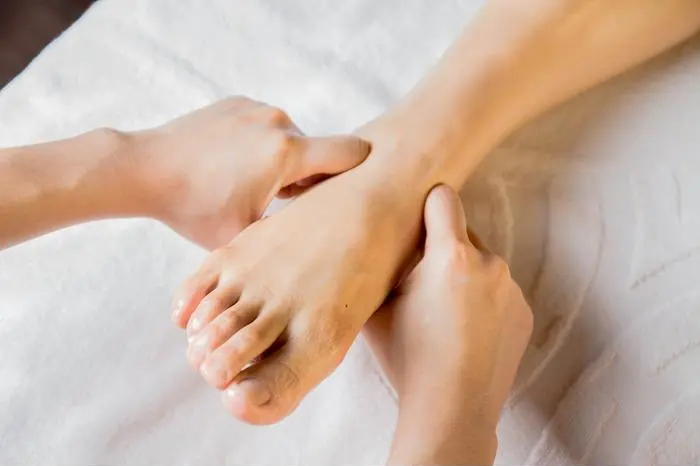The Three-Step Approach
The first step releases the swelling, fluids, ischemia, inflammation and surface trigger points with their related pain referral zones using milking strokes with tolerable pressure to clear surface and intermediate layers of tissue. The second step is the directed myofascial unwinding process. To unwind the myofascial holding pattern, deeper strokes are applied in specific directions to facilitate a more precise release into structural balance, rather than releasing randomly. The third step is the individual fiber releases. When most of the holding pattern has been released, the only remaining tissues resistant to structural balance are individual fibers of muscles or fascia, scar tissue and adhesions within the fascia. Areas that were initially painful to light palpation are now able to be released with deep slow strokes due to the previous steps.
This three-step approach makes it possible to work from superficial to deep in the initial sessions, while staying within the client’s pain tolerance. Using this approach, significant long-term structural change is initiated with a significant reduction of pain in the very first treatment session, and subsequent sessions become even more effective. I found that in working the body with in the three-step approach my motto became “the deeper you go, the slower you go.”
The focus of this therapy was on releasing the core distortion pattern (anterior/posterior rotation of the iliums) that was evident in all my clients. It was also very possibly the basis of 90 percent of the painful symptoms and conditions they experienced. With the use of SOT blocks and specific soft-tissue protocols, I had achieved a level of success, but I could not be confident that my clients would not slip back into this distortion through some life activity or trauma. I was searching for a treatment that would stabilize the relationship of the sacrum and ilium long term. Fortunately it was on the horizon.
It was my privilege to share clients with Dallas Hancock, DC, LMT, as he was developing his Craniostructural Integration techniques. He discovered that he could stretch and release the adhesions and restrictions of the soft tissue within the craniosacral mechanism by using the sphenoid and occiput as handles. Thus, he was no longer limited to working within the existing soft-tissue restrictions of the cranial motion. He observed that the torsion pattern found in the pelvis was mirrored in the cranium in the relationship of the sphenoid and occiput via the sphenobasilar synchondrosis, the joint where the two bones meet.
When he released the cranial soft-tissue restrictions that were holding this torsion in the cranium, he discovered that the torsion of the iliums and tippage of the sacrum released and began moving into balance. This in itself was a major breakthrough! Even more significant was that, once released, the pelvic distortion did not return, and the sacrum/ilium relationship was able to maintain structural integrity long term. The apparent weakness of the ligaments and connective tissue between the sacrum and ilium appeared strengthened to the degree that they would no longer have a weight bearing separation that had been the basis of the structural collapse syndrome. Consequently, studying this osteopathic modality and integrating it into my therapies became a necessity. This was a natural development in the progression of SET.
The body began immediately unwinding (releasing) the structural distortions and chronic myofascial holding patterns from the feet to the head, but a substantial portion of the soft tissue remained resistant to this change. So, I combined Craniostructural Integration techniques with my specific soft-tissue protocols to facilitate the maximum reduction of the old structural distortion, and found that clients were attaining and actually maintaining a level of pelvic balance and structural integrity within the first couple of sessions. Using this combination, it was necessary to alter some of Dr. Hancock’s Craniostructural techniques, and, thus, the Cranial/Structural technique emerged that integrated these cranial techniques necessary to balance the pelvis, and the soft-tissue releases of the entire body. Now we were really “outside of the box” – a whole new paradigm.
This was one more reason not to be restricted to the 10-session series. Every step I took to this point in developing structural balancing techniques now paid off in quantum leaps when coupled with the Cranial/Structural releases. What began as one un-torquing motion of the cranium evolved into the current system of many sophisticated cranial release patterns that include structural as well as functional releases utilizing kinesiology for evaluation and confirmation.

New Frontier
Long-term pelvic balancing was seldom accomplished prior to incorporating the Cranial/Structural techniques. Now the structure of the body would start to balance as soon as the cranium was mobilized by using these new techniques. Every one of my sessions began with a structural evaluation, cranial evaluation and cranial correction/mobilization, followed by specific deep soft-tissue myofascial techniques to release the most restrictive soft tissue of the old structural pattern. Using this combination of techniques, the release of the distortion throughout the whole structure was initiated with cranial releases, and the client’s initial area of discomfort was addressed by the soft-tissue work.
After a more complete release of the core distortion pattern using the Cranial/Structural techniques and the soft tissue releases, secondary patterns began emerging. The work took on another new flavor; a new evolution had come. Each sub-pattern had a cranial distortion associated with it. The release of the cranial distortion initiated the release of the sub-pattern structurally, but it could not be totally released without the application of the specialized deep soft tissue protocols. At present there are at least 12 distinct sub-patterns with many individualized variations.
There appears to be a number of reasons for this. These sub-patterns can be related to:
- additional injuries that were not directly related to the core distortion;
- how the client compensated for the core distortion;
- body personality characteristics
- the strength and development of the musculature based on the client’s previous physical activities;
- the client’s overall condition and muscle tonus;
- the client’s general physical and emotional health;
- the blocking of emotional expression;
- pattern injuries such as one-sided sports activities, or internal rotation of arms while working on computers.

These are just a few of the characteristics that illustrate the individuality and uniqueness of each client. Consequently, in the process of unwinding into balance, some clients will progress through many sub-patterns, others will only experience a few, and each client will respond at a different rate to the corrections. The structural sub-patterns are challenging in that they need to be evaluated with body reading and kinesiology at the beginning of each session.
However, the cranial correction and specific soft-tissue protocol, when properly applied, will alleviate the majority of their symptoms and ultimately bring the body into balance long term. This creates a therapy that focuses on the unique needs of each client, not on a predetermined progression of treatment. Clients receive totally individualized treatment based on their structural distortions, life history, and overall physical and emotional health. Their treatments are discontinued when they can maintain structural balance and resume normal life activities pain free.
Combining Cranial/Structural techniques with specific protocols for deep soft tissue releases results in the maximum level of total rehabilitation possible for each client. This is Structural Energetic Therapy, and it will continue to evolve and expand as the awareness and understanding of the variety and uniqueness of our clients and their needs grow.
